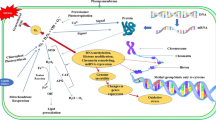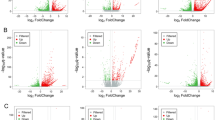Abstract
The heat shock proteins (HSPs) are a family of proteins whose expression is enhanced in response to environmental stressors. The Apostichopus japonicus hsp90 and hsp26 genes were cloned using expressed sequence tag and rapid amplification of cDNA ends techniques. The full-length cDNA of Aphsp90 and Aphsp26 contains 3,458 and 1,688 nucleotides encoding 720 and 236 amino acids, respectively. Multiple alignments indicated that the deduced amino acid sequences of ApHsp90 and ApHsp26 shared a high level of identity with Hsp90 and small SHPs (sHSPs) sequences of zebrafish, ant, acorn worms, etc., and shared identical structural features with Hsp90 and sHSPs. The expression profiles of these two genes under heat treatment were investigated by real-time quantitative PCR. It was found that the messenger RNA (mRNA) transcripts of the two A. japonicus genes varied among different tissues under normal conditions and heat shock, and that the mRNA expression of the two genes was higher in the intestine compared to other tissues. Heat shock significantly elevated the expression of Aphsp90 and Aphsp26 mRNA in a temperature- and time-dependent manner. The results indicate that Aphsp90 and Aphsp26 played important roles in mediating the environmental stress in A. japonicus.









Similar content being viewed by others

References
Abele D, Heise K, PÖrtner HO, Puntarulo S (2002) Temperature-dependence of mitochondrial function and production of reactive oxygen species in the intertidal mud clam Mya arenaria. J Exp Biol 205:1831–1841
Altschul SF, Madden TL, Schäffer AA, Zhang J, Zhang Z, Miller W, Lipman DJ (1997) Gapped BLAST and PSI-BLAST: a new generation of protein database search programs. Nucleic Acids Res 25:3389–3402
Arrigo AP, Landry J (1994) Expression and function of the low molecular weight heat shock proteins. In: Morimoto R, Tissieres A, Georgopoulos C (eds) Structure, function and regulation. Cold Spring Harbor Laboratory Press, Cold Spring Harbor, pp 335–373
Bruce JL, Price BD, Coleman N, Calderwood SK (1993) Oxidant injury rapidly activates the heat shock transcription factor but fails to increase levels of heat shock proteins. Cancer Res 53:12–15
Caplan AJ (1999) HSP90’s secrets unfold: new insights from structural and functional studies. Trends Cell Biol 9:262–268
Chang ES (2005) Stressed-out lobsters: crustacean hyperglycemic hormone and stress proteins. Integr Comp Biol 45:43–50
Chen JX (2004) Present status and prospects of sea cucumber industry in China. In: Lovatelli A, Conand C, Purcell S, Uthicke S, Hamel JF, Mercier A (eds) Advances in sea cucumber aquaculture and management, vol. 463. FAO, Rome, pp 25–38
Chen YM, Kuo CE, Wang TY, Huang SL (2010) Cloning of an orange-spotted grouper Epinephelus coioides heat shock protein 90AB(HSP90AB) and characterization of its expression in response to nodavirus. Fish Shellfish Immunol 28:895–904
Choresh O, Loya Y, Müller WEG, Wiedenmann J (2003) The mitochondrial 60-kDa heat shock protein in marine invertebrates: biochemical purification and molecular characterization. Cell Stress Chaperones 9:38–48
Chow AM, Ferrier-Pagès C, Khalouei S, Reynaud S, Brown IR (2009) Increased light intensity induces heat shock protein Hsp60 in coral species. Cell Stress Chaperones 14:469–476
Crack JA, Mansour M, Sun Y, MacRae TH (2002) Functional analysis of a small heat shock/a-crystallin protein from Artemia franciscana: oligomerization and thermotolerance. Eur J Biochem 269:933–942
Craig EA (1985) The heat shock response. CRC Crit Rev Biochem 18:239–280
Dong YW, Ji TT, Dong SL (2007) Stress responses to rapid temperature changes of the juvenile sea cucumber Apostichopus japonicus Selenka. J Ocean Univ China 6:275–280
Feder ME, Hofmann GE (1999) Heat-shock proteins, molecular chaperones and the stress response: evolutionary and ecological physiology. Annu Rev Physiol 61:243–282
Fu XY, Xue CH, Miao BC, Li ZJ, Gao X, Yang WG (2005) Characterization of proteases from the digestive tract of sea cucumber (Stichopus japonicus): high alkaline protease activity. Aquaculture 246:321–329
Georgopoulos C, Welch WJ (1993) Role of the major heat shock proteins as molecular chaperones. Ann Rev Cell Biol 9:601–634
Gupta RS (1995) Phylogenetic analysis of the 90-kD heat shock family of protein sequences and an examination of the relationship among animals, plants, and fungi species. Mol Biol Evol 12:1063–1073
Heise K, Puntarulo S, PÖrtner HO, Abele D (2003) Production of reactive oxygen species by isolated mitochondria of the Antarctic bivalve Laternula elliptica (King and Broderip) under heat stress. Comp Biochem Physiol C 134:79–90
Hensold JO, Hunt CR, Calderwood SK, Housman DE, Kingston RE (1990) DNA binding of the heat shock element is insufficient for transcriptional activation in murine erythroleukemia cells. Mol Cell Biol 10:1600–1608
Huang PY, Kang ST, Chen WY, Hsu TC, Lo CF, Liu KF (2008) Identification of the small heat shock protein, HSP21, of shrimp Penaeus monodon and the gene expression of HSP21 is inactivated after white spot syndrome virus (WSSV) infection. Fish Shellfish Immunol 25:250–257
Krebs RA, Feder ME (1997) Deleterious consequences of Hsp70 overexpression in Drosophila melanogaster larvae. Cell Stress Chaperones 2:60–71
Li BQ, Yang HS, Zhang T, Zhou Y (2002) Effects of temperature on respiration and excretion of sea cucumber Apostichopus japonicus. Oceanol Limnologia Sin 33:182–187
Li P, Zha J, Zhou KY (2009) Molecular cloning, mRNA expression, and characterization of HSP90 gene from Chinese mitten crab Eriocheir japonica sinensis. Comp Biochem Physiol B 153:229–235
Liao Y (1997) Fauna sinica: phylum echinodermta class holothuroidea. Science Press, Beijing
Linder B, Jin Z, Freedmans JH, Rubin CS (1996) Molecular characterization of a novel, developmentally regulated small embryonic chaperone from Caenorhabditis elegans. J Biol Chem 271:30158–30166
Liu GB (2008) Artificial breeding of thermaltolerant strain of sea cucumber. Doctoral thesis. Institute of Oceanology, Chinese Academy of Sciences
MacRae TH (2000) Structure and function of small heat shock/a-crystallin proteins: established concepts and emerging ideas. Cell Mol Life Sci 57:899–913
Parsell DA, Lindquist S (1993) The function of heat-shock proteins in stress tolerance: degradation and reactivation of damaged proteins. Annu Rev Genet 27:437–496
Pearl LH, Prodromou C (2006) Structure and mechanism of the Hsp90 molecular chaperone machinery. Annu Rev Biochem 75:271–294
Picard D (2002) Heat-shock protein 90, a chaperone for folding and regulation. Cell Mol Life Sci 59:1640–1648
Pinsino A, Thorndyke MC, Matranga V (2007) Coelomocytes and post-traumatic response in the common sea star Asterias rubens. Cell Stress Chaperones 12:331–341
Reineke A (2005) Identification and expression of a small heat shock protein in two lines of the endoparasitic wasp Venturia canescens. Comp Biochem Physiol A 141:60–69
Rosic NN, Pernice M, Dove S, Dunn S (2011) Gene expression profiles of cytosolic heat shock proteins Hsp70 and Hsp90 from symbiotic dinoflagellates in response to thermal stress: possible implications for coral bleaching. Cell Stress Chaperones 16:69–80
Sanders BM (1993) Stress proteins in aquatic organisms: an environmental perspective. Crit Rev Toxicol 23:49–75
Shirk PD, Broza R, Hemphill M, Perera OP (1998) α-Crystallin protein cognates in eggs of the moth, Plodia interpunctella: possible chaperones for the follicular epithelium yolk protein. Insect Biochem Mol Biol 28:151–161
Soetaert A, Moens LN, Van der Ven K, Van Leemput K, Naudts B, Blust R, De Coen WM (2006) Molecular impact of propiconazole on Daphnia magna using a reproduction-related cDNA array. Comp Biochem Physiol C 142:66–76
Tomanek L (2002) The heat-shock response: its variation, regulation and ecological importance in intertidal gastropods (genus Tegula). Integr Comp Biol 42:797–807
van Montfort RLM, Basha E, Friedrich KL, Slingsby C, Vierling E (2001) Crystal structure and assembly of a eukaryotic small heat shock protein. Nat Struct Biol 8:1025–1030
Viant MR, Werner I, Rosenblum ES (2003) Correlation between heat-shock protein induction and reduced metabolic condition in juvenile steelhead trout (Oncorhynchus mykiss) chronically exposed to elevated temperature. Fish Physiol Biochem 29:159–171
Wahid A, Gelani S, Ashraf M, Foolad MR (2007) Heat tolerance in plants: an overview. Environ Exp Bot 61:199–223
Wang FY, Yang HS, Gao F, Liu GB (2008) Effects of acute temperature or salinity stress on the immune response in sea cucumber Apostichopus japonicus. Comp Biochem Physiol A 151:491–498
Wanilada R, Rungnapa L, Pikul J (2010) Expression and distribution of three heat shock protein genes under heat shock stress and under exposure to Vibrio harveyi in Penaeus monodon. Dev Comp Immunol 10:1082–1089
Welch WJ (1992) Mammalian stress response: cell physiology, structure/function of stress proteins, and implications for medicine and disease. Physiol Rev 72:1063–1081
Wu LT, Chu KH (2008) Characterization of heat shock protein 90 in the shrimp Metapenaeus ensis: evidence for its role in the regulation of vitellogenin synthesis. Mol Reprod Dev 75:952–959
Yang HS, Zhou Y, Zhang T, Yuan XT, Li XX, Liu Y, Zhang FS (2006) Metabolic characteristics of sea cucumber Apostichopus japonicus Selenka during aestivation. J Exp Mar Biol Ecol 330:505–510
Zhang Q, Denlinger DL (2010) Molecular characterization of heat shock protein 90, 70 and 70 cognate cDNAs and their expression patterns during thermal stress and pupal diapause in the corn earworm. J Insect Physiol 56:138–150
Acknowledgments
This work was supported by the agricultural seed project of Shan Dong province and the National Key Technology R&D Program (2006AA10A411).
Author information
Authors and Affiliations
Corresponding author
Electronic supplementary materials
Below is the link to the electronic supplementary material.
ESM 1
(DOC 45.0 kb)
Rights and permissions
About this article
Cite this article
Zhao, H., Yang, H., Zhao, H. et al. The molecular characterization and expression of heat shock protein 90 (Hsp90) and 26 (Hsp26) cDNAs in sea cucumber (Apostichopus japonicus). Cell Stress and Chaperones 16, 481–493 (2011). https://doi.org/10.1007/s12192-011-0260-z
Received:
Revised:
Accepted:
Published:
Issue Date:
DOI: https://doi.org/10.1007/s12192-011-0260-z



